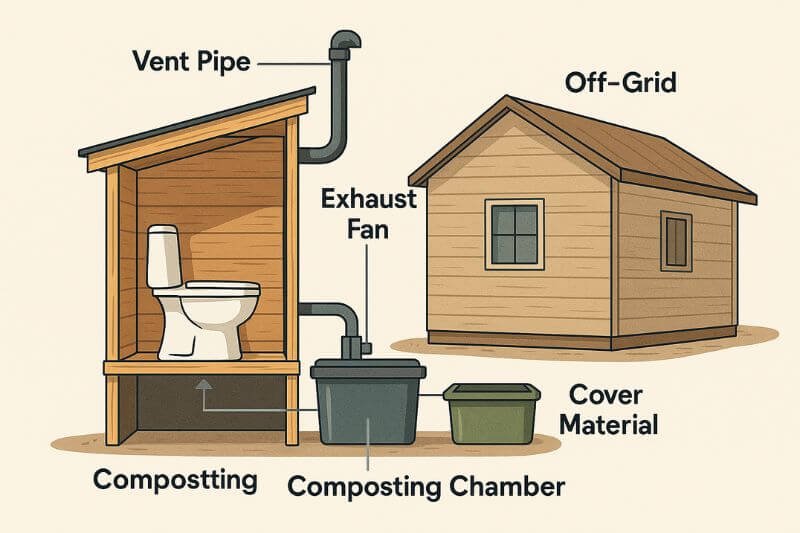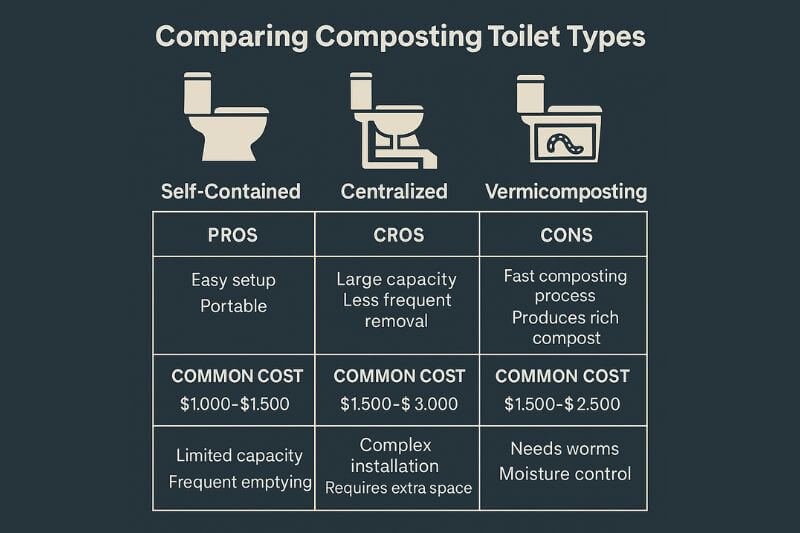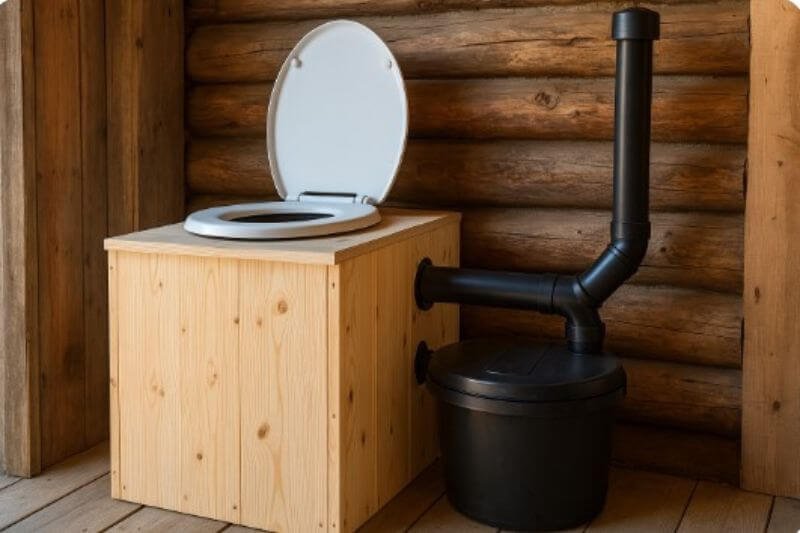🚽 Introduction – Composting toilets off-grid are essential for sustainable independence.
When you live off the grid, managing sanitation isn’t just about convenience — it’s about safety, sustainability, and system resilience. Unlike septic tanks or chemical toilets, composting toilets off-grid provide a waterless, eco-friendly solution that aligns perfectly with the survivalist mindset.
They require no plumbing, no municipal hookups, and — when properly managed — can turn waste into a safe, odorless, and usable resource.
🧱 Part 1: The Basics of Composting Toilets Off the Grid
🌿 What Is a Composting Toilet?
A composting toilet is a dry sanitation system that biologically processes human waste through aerobic decomposition and evaporation. Unlike traditional toilets, it uses no water to flush. Instead, waste is stored in a sealed chamber where it breaks down over time into compost.
Key goals:
- Eliminate pathogens
- Reduce volume by evaporation
- Create a safe, reusable by-product
“A composting toilet is not just a toilet — it’s a miniature ecosystem that transforms waste into soil.” — EcoSan Resilience Field Guide, 2023
🔄 How It Works: Step-by-Step Breakdown
Here’s how a basic composting toilet functions:
- User deposits waste (urine and feces) into a dry chamber
- Carbon material (e.g., sawdust, peat moss) is added to balance moisture and neutralize odors
- Aerobic bacteria decompose the waste over time
- Evaporation removes moisture (some models use a vent fan)
- Compost chamber stores the material until it’s safe to handle
🧻 Toilet paper can be added too — as long as it’s unbleached and biodegradable.
🔧 Types of Composting Toilets for Off-Grid Use
There are two main categories of composting toilets used in off-grid survival settings:
| Type | Description | Maintenance Level | Cost |
|---|---|---|---|
| Self-Contained | Combines toilet seat + compost chamber in one unit | Low | $$ |
| Split/Remote Chamber | Toilet seat drains to a separate compost bin outside | Medium | $$$ |
Sub-types:
- Batch systems: Use rotating bins or buckets
- Continuous systems: Constant input/output (e.g., Nature’s Head, Sun-Mar)
- DIY systems: Buckets with airflow and carbon layers
🧪 What Materials Help Composting?
To support decomposition and control odors, you need to add bulking agents after each use:
- 🌾 Sawdust (untreated)
- 🌱 Peat moss
- 🍂 Dry leaves
- 🌾 Coconut coir
These materials:
- Add carbon to balance nitrogen from waste
- Absorb excess moisture
- Prevent flies and bacteria from spreading
“The ideal carbon-to-nitrogen ratio in a compost toilet is about 25–30:1” — Humanure Handbook, 4th Ed.
🌬️ Odor Control: Does It Smell?
Surprisingly — no, if done right.
Composting toilets don’t smell like a latrine when managed properly. In fact, a poorly ventilated flush toilet can smell worse.
Key odor prevention measures:
- Add bulking material after each use
- Ensure constant airflow (chimney or solar fan)
- Keep system dry (moisture causes anaerobic odor)
- Clean the toilet seat and surrounding area regularly
✅ Well-designed systems emit only a faint earthy smell — like garden compost.
🛠️ Is It Legal to Use a Composting Toilet Off-Grid?
In most U.S. states and many countries, composting toilets are:
- ✅ Permitted for off-grid homes, cabins, and eco-villages
- ⚠️ Regulated in some counties — may require a secondary graywater plan
- 🛑 Restricted in some cities due to septic mandates or code enforcement
📜 Always check:
- County building code
- State sanitation regulations
- HOA rules (if applicable)
🧭 Real-Life Setup: Mountain Cabin in Montana
Marcus and Eliza live in a log cabin in northern Montana, 12 miles from the nearest road. Without septic access or grid power, they installed a DIY batch composting system using:
- A plywood box with a toilet seat
- 5-gallon buckets (rotated weekly)
- Sawdust and dry pine needles as cover material
- A compost pile 200 feet from water sources
“No smell. No waste. Just self-reliance. It’s the most reliable system in the entire cabin.” – Marcus S.
🛠️ Part 2: Installation, Use, and Maintenance of Composting Toilets Off-Grid
🔨 How to Build a DIY Composting Toilet (Simple Setup)
You don’t need a fancy $1,000 unit to get started. Many off-gridders — especially preppers and homesteaders — opt for DIY systems.
🔧 Materials:
- Plywood box or wooden crate
- Toilet seat (can be salvaged)
- 5-gallon buckets (2–4 recommended)
- Hinged lid or top panel
- Urine separator (optional)
- Bulking material bin (for sawdust/peat moss)
Instructions:
- Cut a hole in the top of the box to fit your toilet seat.
- Place a 5-gallon bucket underneath.
- Keep a scoop and dry carbon material nearby.
- Add a handful of sawdust before first use.
- After each use, cover waste with more sawdust.
🛑 Important: Always rotate full buckets into an external compost area far from water sources.
🚽 Installing a Commercial Composting Toilet
For more advanced systems (like Nature’s Head or Sun-Mar), installation is fairly straightforward:
You’ll need:
- A stable floor or platform
- Ventilation pipe (PVC or flexible hose, vertical)
- 12V fan or passive airflow for odor control
- Access to remove compost bin periodically
💡 Most off-grid models run on DC power (great for solar setups) and include:
- Internal mixing crank
- Urine diverter
- Liquid overflow bottle or drainage hose
✅ These units are ideal for tiny homes, cabins, boats, or full-time off-grid living.

🧃 Managing Liquid Waste: Urine Separation
Urine is high in nitrogen and can disrupt the composting balance if not handled properly. Many composting toilets use urine diversion systems:
- Front bowl channel diverts urine to a jug or drain line
- Helps keep the compost chamber dry (preventing smells)
- Urine can be diluted 1:10 and used for non-food crops (like trees or ornamentals)
“Urine separation increases composting speed, reduces smell, and reduces waste volume by up to 60%.” — DrySanitation Institute, 2022
📦 Disposing of Finished Compost
The golden rule: compost must be fully aged and pathogen-free before any reuse.
🕒 Composting humanure takes 6–12 months, depending on:
- Temperature
- Moisture
- Carbon ratio
- Turning frequency
When ready:
- It looks like dark, crumbly soil
- Has no foul smell
- Contains no recognizable waste
Safe disposal options:
- Bury in a dedicated humanure pit
- Use around trees or non-edible plants
- Mix with brush and leaf compost far from garden beds
⚠️ NEVER use fresh compost on food crops.
🧼 Cleaning & Maintaining Your Composting Toilet
Basic routine = less mess, less stress.
Weekly:
- Empty full collection bucket
- Clean seat and bucket interior with vinegar or eco-friendly spray
Monthly:
- Check and clean ventilation fans
- Scrub interior chamber with mild soap
- Inspect seals and lids
Annually:
- Deep-clean and oil moving parts (e.g., crank handles)
- Check compost pile location for runoff or animal intrusion
“Neglected compost toilets fail fast. But a 5-minute weekly check keeps the system running for years.” — Off-Grid Sanitation Handbook
🔄 Mistakes to Avoid (And How to Fix Them)
| Mistake | Problem Caused | Fix |
|---|---|---|
| Too much liquid in chamber | Smell, anaerobic decay | Improve urine separation + add more sawdust |
| Not enough carbon cover | Flies, bad smell | Use more bulking material after each use |
| Incomplete composting time | Unsafe, smelly material | Wait full 6–12 months before using |
| No airflow or fan | Condensation, mold, odor | Add passive chimney or 12V fan |
| Tank placed too close to house | Smell infiltration | Place compost area 100–200 ft downwind |
🧭 Off-Grid Homestead Case Study: Vermont Forest Site
Jared and Lena live off-grid in a 400 sq. ft. yurt in Vermont. Their sanitation setup:
- Nature’s Head composting toilet
- Solar-powered ventilation fan
- External compost bay under a tarped shelter
- Urine diverted to gravel trench with cattails
Their compost pile freezes in winter but finishes decomposition in spring. Waste is handled 100% off-grid, zero discharge.
“The freedom from plumbing and septic bills is amazing. And we’re producing compost, not sewage.” – Lena W.
🌿 Part 3: Long-Term Sustainability, Legal Aspects, and Survival Use of Composting Toilets Off-Grid
⚖️ Composting Toilets vs. Septic and Chemical Toilets

When it comes to sanitation off-grid, composting toilets aren’t the only option — but they’re often the smartest.
🚽 Septic Systems
- Require heavy equipment and permits
- Cost $10,000–$30,000+ to install
- Need large leach fields
- Risk of groundwater contamination if poorly managed
🧪 Chemical Toilets
- Portable but short-term
- Require chemical refills
- Produce toxic wastewater
- Not suitable for long-term or eco-resilient use
✅ Composting Toilets (Summary)
| Feature | Composting Toilet | Septic System | Chemical Toilet |
|---|---|---|---|
| Water Use | None | High | Low |
| Installation Cost | $200–$2,000 | $10,000+ | $100–$300 |
| Long-Term Viability | Excellent | Medium | Poor |
| Environmental Impact | Very Low | Moderate | High |
| Mobility | High | None | High |
Verdict: For off-grid homesteads, bug-out locations, and survival setups — composting toilets are the most self-reliant and eco-conscious option.
🛡️ Legal and Environmental Considerations
Are composting toilets legal everywhere?
Not always — though they are increasingly accepted in off-grid communities, tiny home zoning, and eco-villages.
Check your location for:
- State building codes (especially in California, Colorado, Vermont)
- County wastewater ordinances
- Whether greywater systems are also required
In the U.S., models like Nature’s Head and Sun-Mar are NSF-certified, which helps with approval in stricter counties.
✅ Many survivalists install composting toilets on unpermitted land without issues — especially in rural areas or bug-out shelters.
“Sanitation is public health. A properly managed compost toilet is safer than an outdated septic system.” — Environmental Health Coalition, 2021
🔄 Long-Term Sustainability & Redundancy
No system is foolproof. Here’s how to future-proof your composting toilet setup.
🛠️ Recommended Backups:
- Extra 5-gallon buckets (in case of damage or overflow)
- A basic chemical toilet for emergencies
- Extra bags of sawdust or bulking material
- Vinegar or eco-cleaner stockpile for sanitization
- Tarps for weatherproofing your external compost pile
♻️ Enhancing the System:
- Use a solar-powered fan for continuous airflow
- Collect rainwater or greywater for separate handwashing setup
- Create a two-stage composting system to allow one pile to rest while using the other
🧠 Survival Benefits of Composting Toilets
In a survival context — when the grid is down or society collapses — toilets become more than comfort. They’re a source of hygiene, dignity, and disease control.
Why composting toilets are ideal for crisis scenarios:
- No water needed
- No power grid dependency
- Can be relocated or hidden
- Neutralizes waste safely
- Generates soil instead of sewage
In refugee camps and disaster zones, composting toilets are often the only viable solution for extended sanitation.
❓ Frequently Asked Questions (FAQ)
Q: How long does it take for compost to become safe to handle?
The safe composting of human waste requires patience and biology. When managed properly — with the right aeration, carbon balance, and temperature — human waste can fully decompose into harmless compost within 6 to 12 months.
Signs that compost is safe to handle:
- Looks like rich, dark soil
- Smells earthy — no trace of fecal odor
- Shows no visible toilet paper, food, or waste remnants
For absolute safety:
- Use this compost only on trees, shrubs, or ornamental gardens
- Wait at least 2 years if you ever intend to use it on edible plants (according to WHO and Humanure Handbook recommendations)
“Pathogens like E. coli and parasites die off naturally over time — but only if oxygen, heat, and time do their job.” — Dr. Jenkins, Humanure Pioneer
🛑 Never apply undercooked compost to food crops — it’s not worth the risk.
Q: Can composting toilets be used in cold climates?
Yes — but they require seasonal adjustments.
Decomposition slows down when temperatures fall below 50°F (10°C), and it can halt completely in freezing weather. But that doesn’t mean the system fails — it just pauses until warmer days return.
Winter strategies:
- ❄️ Keep external compost bins covered and insulated (e.g., with straw bales, tarps, or compost blankets)
- ❄️ Store full buckets in a dry shed or container until spring
- 🔥 Use internal heaters in high-end models or compost inside a greenhouse-style structure
- ✅ Use extra bulking material to absorb condensation and prevent frozen waste
💬 Many off-gridders in Alaska, Vermont, and the Rockies successfully use composting toilets year-round — the key is accepting that composting is seasonal, not instantaneous.
Q: Do composting toilets attract flies or wild animals?
Not if properly managed.
Flies are attracted to moisture and exposed waste. Animals (like raccoons, dogs, or bears) are interested in smell and accessibility. A well-maintained composting toilet gives them neither.
Prevention checklist:
- ✅ Always add a carbon cover after every use (sawdust, peat moss, dry leaves)
- ✅ Keep the lid sealed tightly at all times
- ✅ Ensure proper ventilation airflow (passive or powered)
- ✅ Position compost piles downwind and far from the home (at least 100–200 ft)
- ✅ For extra security, enclose your compost bins with fencing or store in elevated drums
“I’ve used compost toilets in the deep woods for over a decade. Never once had a fly problem — just don’t skip the sawdust.” — Tony K., Off-Grid Homesteader, Maine
Q: What happens if I overfill the system or forget to empty it?
An overflowing composting toilet is more than a nuisance — it’s a health hazard.
When the chamber is full, two things happen:
- Waste piles above the air zone, triggering anaerobic decay (smells like rotten eggs)
- Composting slows or stops altogether
🧯 Fix it fast:
- ✅ Immediately move waste to your external compost site or backup bin
- ✅ Add extra bulking material to reestablish a dry, oxygen-rich balance
- ✅ Clean the interior of the toilet with vinegar or a bio-safe cleaner
- ✅ Inspect ventilation — if airflow was poor, this may have triggered the issue
💡 Tip: Keep 2–3 backup buckets or bins nearby to rotate when the main chamber fills — this is especially useful in family setups or group retreats.
“Overflow is a sign your rhythm is off — not that the system doesn’t work. Prep like a pro and you’ll never face it again.” — Off-Grid Toilet Field Guide, 2024
✅ Conclusion: The Future of Sanitation Is Off the Grid
Composting toilets off-grid aren’t just about survival — they’re about reclaiming control of one of life’s most fundamental needs.
They offer:
- Independence from fragile infrastructure
- Eco-friendly waste reuse
- Simple, maintainable design
- Peace of mind in a crisis
If you’re building a bug-out location, prepping your off-grid homestead, or transitioning to self-reliance — this is one system you can’t afford to ignore.
💬 Your resilience begins where the flush ends.















